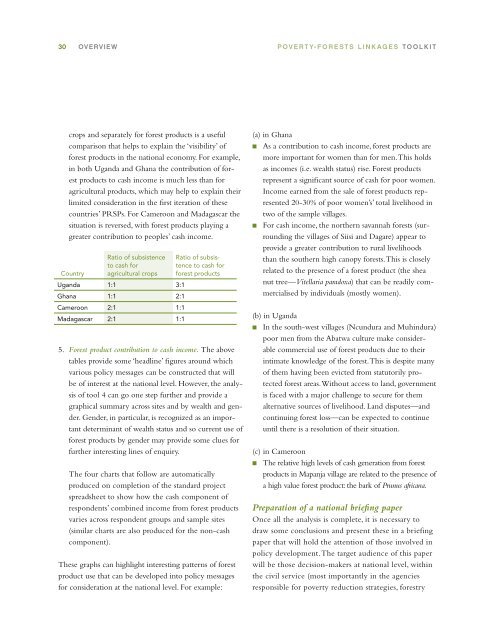Poverty-Forests Linkages Toolkit - IUCN
Poverty-Forests Linkages Toolkit - IUCN
Poverty-Forests Linkages Toolkit - IUCN
You also want an ePaper? Increase the reach of your titles
YUMPU automatically turns print PDFs into web optimized ePapers that Google loves.
30 OVERVIEW<br />
POVERTY-FORESTS LINKAGES TOOLKIT<br />
crops and separately for forest products is a useful<br />
comparison that helps to explain the ‘visibility’ of<br />
forest products in the national economy. For example,<br />
in both Uganda and Ghana the contribution of forest<br />
products to cash income is much less than for<br />
agricultural products, which may help to explain their<br />
limited consideration in the first iteration of these<br />
countries’ PRSPs. For Cameroon and Madagascar the<br />
situation is reversed, with forest products playing a<br />
greater contribution to peoples’ cash income.<br />
Country<br />
Ratio of subsistence<br />
to cash for<br />
agricultural crops<br />
Ratio of subsistence<br />
to cash for<br />
forest products<br />
Uganda 1:1 3:1<br />
Ghana 1:1 2:1<br />
Cameroon 2:1 1:1<br />
Madagascar 2:1 1:1<br />
5. Forest product contribution to cash income. The above<br />
tables provide some ‘headline’ figures around which<br />
various policy messages can be constructed that will<br />
be of interest at the national level. However, the analysis<br />
of tool 4 can go one step further and provide a<br />
graphical summary across sites and by wealth and gender.<br />
Gender, in particular, is recognized as an important<br />
determinant of wealth status and so current use of<br />
forest products by gender may provide some clues for<br />
further interesting lines of enquiry.<br />
The four charts that follow are automatically<br />
produced on completion of the standard project<br />
spreadsheet to show how the cash component of<br />
respondents’ combined income from forest products<br />
varies across respondent groups and sample sites<br />
(similar charts are also produced for the non-cash<br />
component).<br />
These graphs can highlight interesting patterns of forest<br />
product use that can be developed into policy messages<br />
for consideration at the national level. For example:<br />
(a) in Ghana<br />
n As a contribution to cash income, forest products are<br />
more important for women than for men. This holds<br />
as incomes (i.e. wealth status) rise. Forest products<br />
represent a significant source of cash for poor women.<br />
Income earned from the sale of forest products represented<br />
20-30% of poor women’s’ total livelihood in<br />
two of the sample villages.<br />
n For cash income, the northern savannah forests (surrounding<br />
the villages of Siisi and Dagare) appear to<br />
provide a greater contribution to rural livelihoods<br />
than the southern high canopy forests. This is closely<br />
related to the presence of a forest product (the shea<br />
nut tree—Vitellaria paradoxa) that can be readily commercialised<br />
by individuals (mostly women).<br />
(b) in Uganda<br />
n In the south-west villages (Ncundura and Muhindura)<br />
poor men from the Abatwa culture make considerable<br />
commercial use of forest products due to their<br />
intimate knowledge of the forest. This is despite many<br />
of them having been evicted from statutorily protected<br />
forest areas. Without access to land, government<br />
is faced with a major challenge to secure for them<br />
alternative sources of livelihood. Land disputes—and<br />
continuing forest loss—can be expected to continue<br />
until there is a resolution of their situation.<br />
(c) in Cameroon<br />
n The relative high levels of cash generation from forest<br />
products in Mapanja village are related to the presence of<br />
a high value forest product: the bark of Prunus africana.<br />
Preparation of a national briefing paper<br />
Once all the analysis is complete, it is necessary to<br />
draw some conclusions and present these in a briefing<br />
paper that will hold the attention of those involved in<br />
policy development. The target audience of this paper<br />
will be those decision-makers at national level, within<br />
the civil service (most importantly in the agencies<br />
responsible for poverty reduction strategies, forestry

















